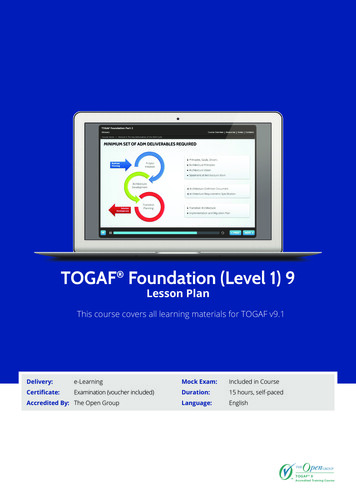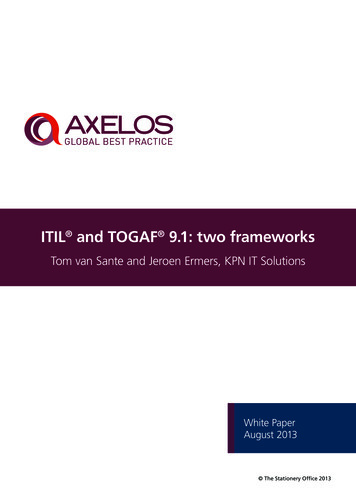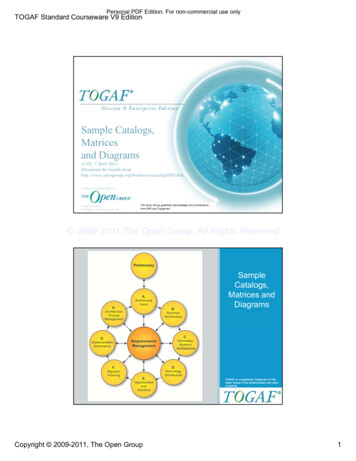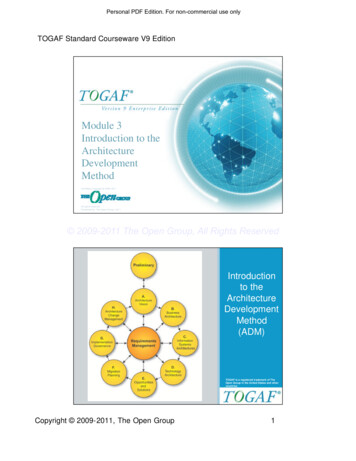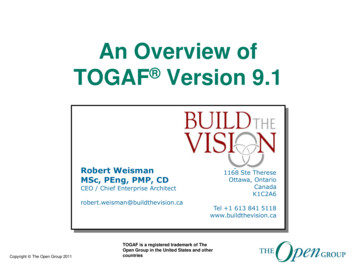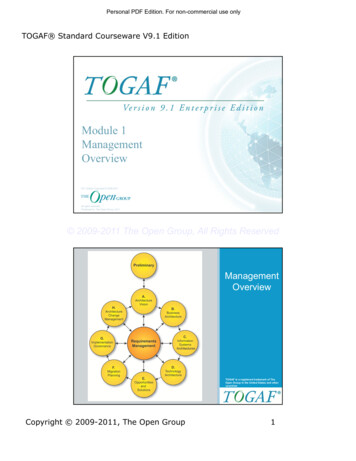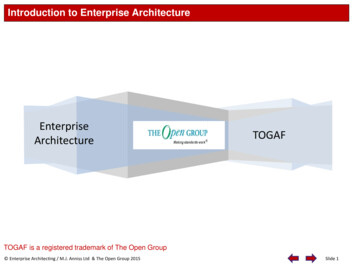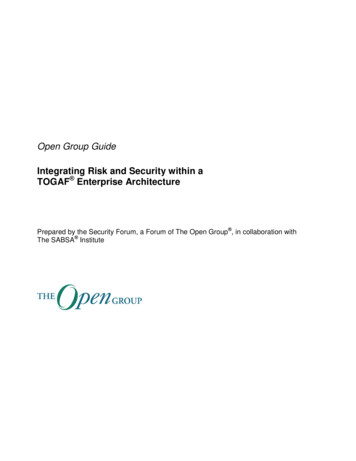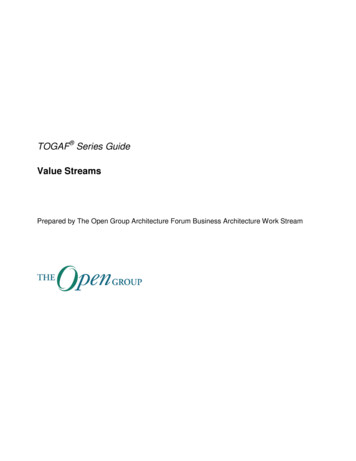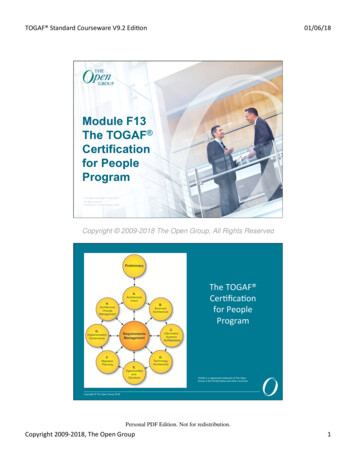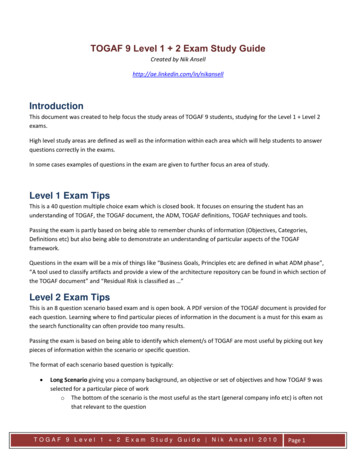
Transcription
TOGAF 9 Level 1 2 Exam Study GuideCreated by Nik ionThis document was created to help focus the study areas of TOGAF 9 students, studying for the Level 1 Level 2exams.High level study areas are defined as well as the information within each area which will help students to answerquestions correctly in the exams.In some cases examples of questions in the exam are given to further focus an area of study.Level 1 Exam TipsThis is a 40 question multiple choice exam which is closed book. It focuses on ensuring the student has anunderstanding of TOGAF, the TOGAF document, the ADM, TOGAF definitions, TOGAF techniques and tools.Passing the exam is partly based on being able to remember chunks of information (Objectives, Categories,Definitions etc) but also being able to demonstrate an understanding of particular aspects of the TOGAFframework.Questions in the exam will be a mix of things like “Business Goals, Principles etc are defined in what ADM phase”,“A tool used to classify artifacts and provide a view of the architecture repository can be found in which section ofthe TOGAF document” and “Residual Risk is classified as ”Level 2 Exam TipsThis is an 8 question scenario based exam and is open book. A PDF version of the TOGAF document is provided foreach question. Learning where to find particular pieces of information in the document is a must for this exam asthe search functionality can often provide too many results.Passing the exam is based on being able to identify which element/s of TOGAF are most useful by picking out keypieces of information within the scenario or specific question.The format of each scenario based question is typically: Long Scenario giving you a company background, an objective or set of objectives and how TOGAF 9 wasselected for a particular piece of worko The bottom of the scenario is the most useful as the start (general company info etc) is often notthat relevant to the questionTOGAF 9 Level 1 2 Exam Study Guide Nik Ansell 2010Page 1
A set of concerns or objectives i.e. things that must be addressed and whyo This is generally the area of the scenario that will allow you build up what the question is reallygetting atThe questiono This is sometimes a simple question like “You have been asked to define what steps you shouldtake in order to best meet the objective” or sometimes a longer question which give a bit moreinformation to further focuses on an area to look for in the answers, like adding more concerns orconstraintsIn some cases the scenario, question and answers are very wordy but actually quite simple. The longest scenarioquestion I got was based around which artifacts to create which address specific concerns. There was a big longlist of concerns worded something like:1.2.3.4.5.6.Needs to be able to understand which systems are used by which business processMust show what data needs to be sharedMust show the locations particular business functions are carried out . .The answers were like:A.B.C.D.Use a xx matrix, use a yyy diagram, a zzz matrix, use a bbb catalogUse a bbb catalog, a ccc matrix, a ppp diagram .The best technique for answering a long and sometimes overwhelming question like this, is to use thepaper/scratch pad the testing centre provides. Write each answer down, then mark off which concern isaddressed by each answer. The one that addresses all the concerns if obviously the right answerEG:A.B.C.D.1,2,5,62,51,61,2,3,4,5,6TOGAF 9 Level 1 2 Exam Study Guide Nik Ansell 2010Page 2
Study AreasTOGAF Document Be comfortable with what topics are covered in each in each part of the TOGAF document (Part 1, Part 2etc). This will make it easier to find things in the open book exam and you may also get a question relatedto where you find particular things in the book. I got a question on where you would find the EnterpriseContinuumEnsure you have a good appreciation for the definitions (Concerns, Foundation Architecture, ReferenceModel, Application, Model etc) as you will get questions on these and the wording is sometimes veryparticular in the exam questions/answersADM Memorize the Name, Order and Associated Letter of each ADM PhaseMemorize the Objectives, Steps and Deliverables for each ADM Phase. The order of steps is alsosometimes important. E.G I was asked a question on what comes before creating a baseline architecturein phases B,C,DLearn the Iterations that can be carried out within the ADM (Context, Definition, Governance, Planning)Be comfortable with the different ways the ADM can be tailored and for what reasonsLearn the Techniques available and which phase they would be used (Architecture Patterns, Gap Analysisetc)Enterprise Continuum Be comfortable that the this is a view of the architecture repository to classify architecture and solutionartifacts, to guide an architecture exercise from the generic to the organization specific and to promotereuseMemorize the architectures and solutions (Foundation, Common Systems Etc) available in the continuumand what you would likely see in each (E.G a Generic Supply Chain Process, Email Solution etc)You may get asked a question on where in the Enterprise Continuum you would find the TOGAF TRM(Foundation Architectures) or the IIIRM (Common Systems Architectures)You may also get asked a question on what the TRM or IIRM is used forBuilding Blocks Know the difference between Solution Building Blocks (Specific Implementation) and ArchitectureBuilding blocks (Fundamental Functionality), what they are used for and at what points in the ADM youdefine and refine themGeneric Memorize the components of an Architecture Library (Architecture MetaModel, Landscape, GovernanceLog etc). Be comfortable with the purpose and TOGAF definition for each oneMemorize the Architecture domains (Technology, Application, Data, Business)Memorize the Document and Metamodel Categorization (Core, Mandated, Recommended, Supporting)Understand the difference between a concern (key interest areas of a stakeholder) and a requirements(Derived from concerns, they are S.M.A.R.T and generally a need that must be fulfilled by an architectureor solution)TOGAF 9 Level 1 2 Exam Study Guide Nik Ansell 2010Page 3
Memorize the 3 different Strategic Implementation Directions (Green Field, Evolutionary, Revolutionary)and what they meanMemorize the 3 different categories of change (Simplification, Incremental and Re-Architecting). Whatactions are required (Change Request or Architecture work) and how to classify a category of change. EG Igot a question that asked to categorize a particular type of change proposedStakeholders, Views, Viewpoints Be comfortable with the TOGAF stakeholder management techniques and what deliverables you wouldcreate to help you do thisRemember a viewpoint is a perspective (where you are looking from) and generally specific to astakeholder groupRemember a view is what you see and is created to ensure that particular stakeholders can see anarchitecture from a point of view which matches their concernsGovernance Know what is in the Governance Repository (Reference Data, Process Status, Audit Information)Learn what stage in the ADM (Phase G) this is carried out and howLearn the roles and responsibilities within any governance frameworkBe comfortable with the TOGAF techniques and process provided for governance activity (ComplianceAssessments etc)Memorize the levels of Architecture Conformance, I remembered it this way:o Fully Conformant: Everything delivered and conformso Conformant: Extra stuff delivered that does not confirm (I linked the “or” in conformant with the“Aug” in augment to memorize)o Compliant: Not everything was deliveredo Consistent: Extra stuff and stuff missingo Irrelevant: Nothing delivered that matches the enterprise architectureRemember that Architecture Contracts are created in this phaseMetamodel Be comfortable with why it exists, how it is used and the core entities (Business: Actor, Process, Functionetc Technology: Platform Service etc)Scoping the Enterprise Memorize the different dimensions that can be used to refine the scope of an Architecture or Solution:o Breadth/Scopeo Level of Detail (Enterprise/Strategic, Segment, Capability)o Time Horizono Architecture Domain (Technology, Business etc)TOGAF 9 Level 1 2 Exam Study Guide Nik Ansell 2010Page 4
Risk Management Memorize the steps in the process and what each step involves at a very high level:o Classificationo Identificationo Initial Risk Assessmento Risk Mitigationo Residual Risk Assessmento Risk MonitoringBe comfortable with the risk classification matrix and the categories of Effects (Catastrophic, Marginaletc), Impacts (Extremely High, High etc) and Frequencies (Frequent, Negligible etc)FootnoteI hope you find this guide useful, my aim was to be helpful and guide study into the right areas, rather than simplyprovide lists of things or questions and answers to memorize. This way I feel helps students to fully appreciate andunderstand TOGAF so it will be easier to apply in their respective organizations.If you have any comments please feel free to pass them on via email to nikansell00@gmail.com or get in touch vialinkedin at: http://ae.linkedin.com/in/nikansell.TOGAF 9 Level 1 2 Exam Study Guide Nik Ansell 2010Page 5
Mar 04, 2017 · the TOGAF document” and “Residual Risk is classified as ” Level 2 Exam Tips This is an 8 question scenario based exam and is open book. A PDF version of the TOGAF document is provided for each question. Learning where to find particular pieces
